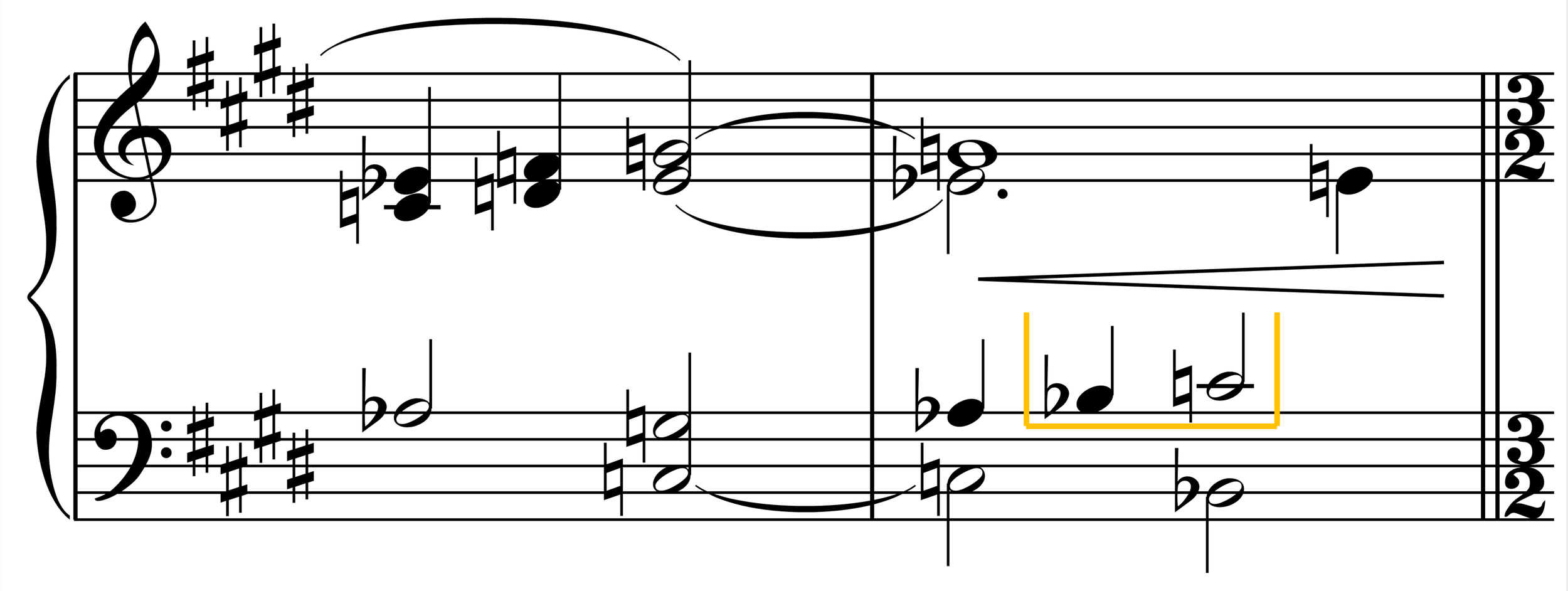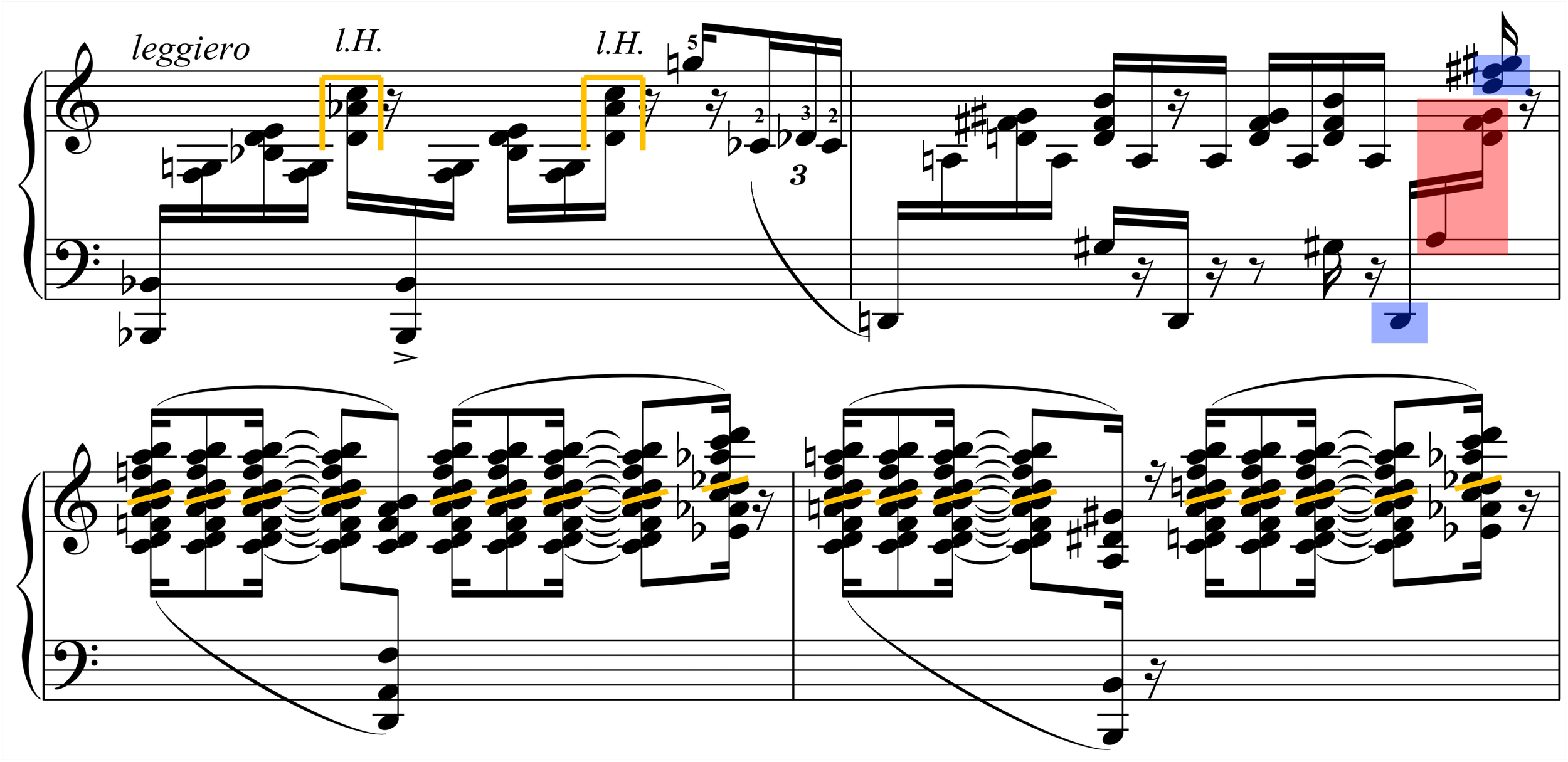“Splitting between hands like this allows the rolled notes to played much more fluidly and in a faster motion.”
Submitted by Wade Troyer
Published on 9/1/2023

“Splitting between hands like this allows the rolled notes to played much more fluidly and in a faster motion.”
Submitted by Wade Troyer
Published on 9/1/2023

“The hand crossing allows you to play pianissimo much easier than try to playing the 2nds as written with one hand.”
Submitted by Wade Troyer
Published on 9/12/2023

LH = blue
RH = red
“The redistribution of notes allows the downbeat to played easier in measure 15, though this takes away the ‘struggle’ or forced broadening that Barber intended. That can still come across though with this restructuring.”
Submitted by Wade Troyer
Published on 9/1/2023

“This fingering helps facilitate a clear counterpoint of the upward moving motif played before in the right hand without muddying the waters with the pedal.”
Submitted by Wade Troyer
Published on 12/14/2022

“Spacing the chord like this helps all the notes to sound at once and keeps that consistent texture without needing to roll or play the notes before or after the 3rd beat. Also, it allows the left hand to hold the low F# through the quick moving harmonies above it without muddying too much with the pedal.”
Submitted by Wade Troyer
Published on 9/1/2023

“Catching the A in left hand helps achieve a smoother bass line with less reliance on the pedal.”
Submitted by Wade Troyer
Published on 12/14/2022

“This splitting of notes between hands allows the chords to not be rolled in the left hand and the pianissimo in the final measures is easier to achieve. Other moments like this occur throughout the piece but this is the one that makes the most sense to alter.”
Submitted by Wade Troyer
Published on 12/14/2022

“The constant, inner, scalar movement of 8th notes is difficult if playing between the hands as written. I enjoy the sound of this movement if using less pedal which necessitates more splitting and picking up notes between hands.”
Submitted by Wade Troyer
Published on 8/31/2023

“The constant, inner, scalar movement of 8th notes is difficult if playing between the hands as written. I enjoy the sound of this movement if using less pedal which necessitates more splitting and picking up notes between hands.”
Submitted by Wade Troyer
Published on 8/31/2023

“The constant, inner, scalar movement of 8th notes is difficult if playing between the hands as written. I enjoy the sound of this movement if using less pedal which necessitates more splitting and picking up notes between hands.”
Submitted by Wade Troyer
Published on 8/31/2023

“Splitting the notes this way can help make the staccato chords more crisp without the need of rolling them.”
Submitted by Wade Troyer
Published on 9/27/2022

“Splitting the notes this way can help make the staccato chords more crisp without the needing of rolling them.”
Submitted by Wade Troyer
Published on 9/27/2022

“Dividing between hands makes this a lot easier to play at the fast tempo this movement demands.”
Submitted by Wade Troyer
Published on 9/27/2022

“The crossing of left hand to hit the top chord in m. 5 rather than playing the division of hands as written is much less precarious.”
Submitted by Wade Troyer
Published on 12/15/22

Submitted by Wade Troyer
Published on 12/15/2022

“Editing the score to take out the doubled ‘D’ between hands make this section much easier to read after the page turn and the splitting between hands a bit easier to play when it doesn't feel as natural as previous moments it happens in the piece.”
Submitted by Wade Troyer
Published on 12/15/2022
“This fingering helps prioritize the smooth line without an over-reliance on pedal that might muddy the texture and overcast the great counterpoint in the inner voices.”
Submitted by Wade Troyer
Published on 9/27/2022


“This fingering helps prioritize the smooth line without an over-reliance on pedal that might muddy the texture and overcast the great counterpoint in the inner voices.”
Submitted by Wade Troyer
Published on 9/27/2022